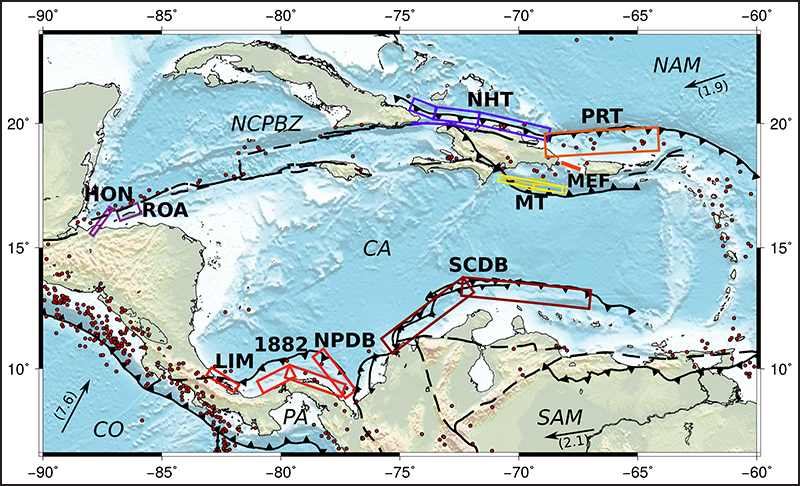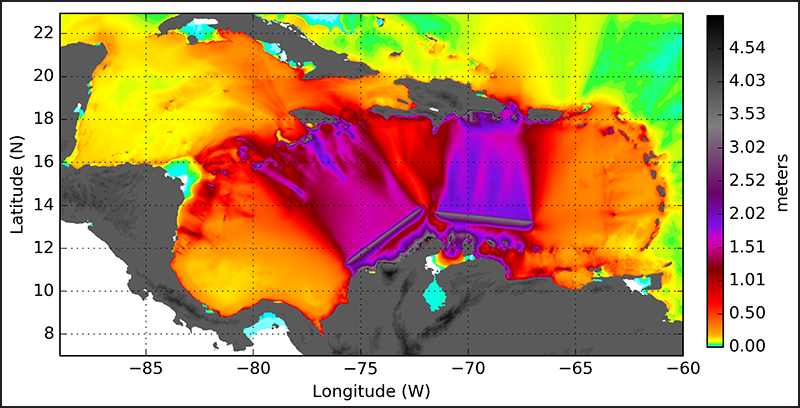Nations work together to size up Caribbean tsunami hazards
This relatively high frequency—one every 25 years—is noteworthy because the Caribbean region is home to about 40 million people, with a growing coastal infrastructure, tourism industry, and population. Of particular concern is how the enclosed nature of the Caribbean basin means that tsunami waves can reach the coastlines in as little as a few minutes to 3–4 hours, in contrast to the 15–20 hours it can take a tsunami to cross the Pacific basin.
Recent catastrophic experiences, such as the 2010 earthquake and tsunami in Haiti, have demonstrated how critical the need is for earthquake and tsunami preparedness in the Caribbean region. Moreover, the region shares similarities in population, tourism, development, and tectonic setting with those of the Indian Ocean, where a massive catastrophic tsunami in 2004 resulted in a quarter of a million deaths.Thus, the Caribbean has become a focus of interest to scientists working to quantify the possible effects and threats of significant tsunamis. What’s more, the potential for massive damage has provided the necessary catalyst to get decision-makers to launch risk reduction programs.
In light of this interest and potential, scientists and policy makers across the region spearheaded an international collaboration through the United Nations Educational, Scientific and Cultural Organization (UNESCO). This collaboration quickly established a permanent working group specifically focused on hazard assessment. The working group has now passed some key milestones: They have defined worst-case tectonic scenarios for several Caribbean subregions.
Sustaining Collective Memory
Tsunamis in the Caribbean basin are not frequent, so it can be challenging to raise awareness of their catastrophic potential. Experiences stemming from these phenomena tend to have a short life span—maybe a couple of generations—in collective memory. This collective memory also tends to be localized in the community or island affected by a past tsunami rather than spanning the region.
The UNESCO collaboration, formed in 2005 following the structure of its Pacific counterpart, is called the Intergovernmental Coordination Group (ICG) for the Tsunami and other Coastal Hazards Warning System for the Caribbean and Adjacent Regions (ICG/CARIBE-EWS). It includes 47 countries and territories: all locations with coasts along the Caribbean Sea and the Gulf of Mexico, as well as locations with coasts farther afield, such as the Bahamas, Bermuda, Brazil, Canada, French Guyana, Guyana, and Suriname.To help keep tsunami awareness alive, ICG/CARIBE-EWS quickly established a permanent working group (WG2) specifically focused on hazard assessment. As members of WG2, our task is to take stock of the potential impacts of tsunamis across Caribbean communities so that emergency planners can pursue risk mitigation and preparedness. More information on WG2 can be found on its website.
Scope, Scenarios, and Sources
For our first assessment, we took a multidisciplinary approach in which experts determined the tsunami potential of selected regions.
The first step was to define credible worst-case tsunami scenarios. During a series of meetings, held under the auspices of UNESCO’s ICG, geologists, seismologists, oceanographers, computer programmers, modelers, and engineers from within and outside the Caribbean region gathered to define and refine potential seismic sources.
Models of the identified scenarios concluded that regardless of the source location in the Caribbean basin, these seismically induced tsunamis are not capable of affecting the whole Caribbean basin, but they can affect a significant fraction of the region. Thus, it is important that communities across the region realize their vulnerabilities and prepare for tsunamis. If they don’t, the assessment concludes, their populations and industries face heightened risks. These simulations also provide useful data to develop tsunami evacuation maps and plans to help mitigate tsunami effects across the Caribbean region.This project builds upon existing reports that have focused on Caribbean tsunami sources. However, our studies have so far focused on tsunamis caused by simple slip earthquakes and have not taken into consideration more complex structures or slow-slip events such as the Nicaragua 1992 earthquake and tsunami. For this reason, the project envisions future studies that elaborate seismic sources with more complex or variable slip distribution as well as those that augment the list of sources to include submarine landslides and volcanic eruptions.
Possible Caribbean Tectonic Sources
So far, our meetings have identified seismic sources affecting northern Hispaniola, Honduras, the southern Dominican Republic, and Central America. The experts attending these meetings mocked up 17 tsunami scenarios using a deterministic approach (Figure 1) [Chacón-Barrantes et al., 2016].

Although some scenarios yield a low probability of occurrence, we still took them into consideration for preparedness purposes. We determined fault parameters by consensus during the respective meetings by considering available data on historical events, seismic density, and the latest geodetic and tectonic studies of the Caribbean. Whenever possible, we used the largest observed earthquakes to estimate the largest probable magnitude where a full rupture can develop.
For each tectonic source we discussed and agreed on tsunami source parameters to compute a maximum likely moment magnitude (Mw) following the Wells and Coppersmith [1994] relationship between rupture size and earthquake magnitude.
To better categorize the 17 tsunami sources modeled for the Caribbean, the group identified four main subregions: (1) northeast, (2) south, (3) southwest, and (4) northwest. Significant historical events have been documented, and recent damaging events have been recorded in some of these subregions.
Subregion 1 has suffered great devastation from at least three major earthquakes. In 1787, the Boricua earthquake originated in the Puerto Rico Trench. The Mw 7.3 San Fermín earthquake in 1918 originated between the islands of Puerto Rico and the Dominican Republic. In 1946, the Mw 8.1 Hispaniola earthquake struck the northern Dominican Republic.In subregion 2, the Caribbean and South American plates collide along the Southern Caribbean Deformed Belt. Current scientific consensus in this region cannot confirm whether this feature is capable of a megathrust earthquake, and there are no historical records in this subregion. However, recent geodetic data have been used to suggest active compression, which implies an increased tsunami risk for the region.
The North Panama Deformed Belt in subregion 3 has the largest number of tsunami records within the Caribbean. They include the devastating event of 1882 in eastern Panama; three strong earthquakes and tsunami with similar characteristics that originated at the border between Costa Rica and Panama in 1798, 1822 (Mw 7.6), and 1991 (Mw7.6); a small tsunami in 1916 in western Panama; and an earthquake in 1904 that caused the uplift of coral reefs in Costa Rica with no associated tsunami records.
The largest run-up—the highest point that the tsunami reached—along the Caribbean coast of Central America occurred in subregion 4 following an earthquake in 1539. More recently, a Mw 7.6 strike-slip earthquake caused a small tsunami in this region in early 2018.
A comprehensive list of events affecting the entire Caribbean region can be found in the Global Historical Earthquake Archive from the Global Earthquake Model and in the database of the National Centers for Environmental Information and its colocated World Data Service for Geophysics. Sources along the Lesser Antilles Arc, where tsunamis affect near-field islands, will be included once an upcoming meeting of experts is held in Martinique in late 2018.
Tsunami Simulations for Local Hazard Assessment
Our group performed tsunami numerical simulations of the 17 sources using the numerical model Tsunami-HySEA[Macías et al., 2017] with a 60–arc second resolution. In all cases, we simulated only tsunami propagation [Chacón-Barrantes et al., 2016]. Our simulations indicate that geomorphology and bathymetry features have a strong effect on the wave propagation. When these features are combined with the type of tsunami source, none of the resulting tsunamis affect the entire Caribbean basin. Figure 2 shows one such example of a large simulated event that affects a large portion of the basin without covering it entirely. However, any future earthquake still has a high chance of affecting a significant portion of it.

An added value of the modeling results is that ICG/CARIBE-EWS member states can apply these results to assess their tsunami hazard and develop mitigation plans. During its annual assembly in 2017, the ICG/CARIBE-EWS declared that creating tsunami evacuation maps is a priority for the region, and they encouraged member states to use these modeling results to develop their own tsunami evacuation maps.
Challenges in the Future
The most significant hurdle WG2 has faced in supporting detailed inundation modeling for specific locations in the Caribbean has been acquiring high-resolution bathymetric data of nearshore regions. Collecting coastal bathymetric data is expensive, and because of possible security concerns, some countries do not provide access to these data. To overcome this, WG2 has worked toward capacity building in the Caribbean, where local governments or agencies might perform their own simulations once they get the proper bathymetric data, favoring the development of their own inundation and evacuation maps.
Although our study illustrates the potential effects of tsunamis that have a seismic source trigger within the region, teletsunamis and tsunamis from other nonseismic sources such as landslides and volcanic eruptions have yet to be considered. The Caribbean basin shows evidence of these sources in past events. Quantifying these additional sources would supplement the existing assessment and provide a more thorough understanding of all tsunami risks for the Caribbean region.
Except where otherwise noted, images are subject to copyright. Any reuse without express permission from the copyright owner is prohibited.






